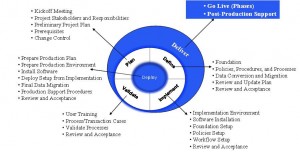Interact HRMS and Interact SSAS Implementation
We provide total implementation and system integration solutions for our Interact HRMS and Interact SSAS products depending on the client needs and requirements. Using our proven structured risk-free implementation methodology, we provide full Implementation and Deployment services including Project Planning, Project Management, Implementation, Training, System Integration, Quality Assurance, Production, Deployment, and Production Support.
Software Globalization
We are a pioneer in software globalization and we have developed a risk-free proven I18N and L10N methodology and associated technologies to globalize software products, both legacy systems as well as application software developed using new technologies..
eGovernment
We provide software development services for medium and large eGovernment software projects. We either use our rapid development business objects framework, or we can use third party frameworks, depending on the client’s requirements..
System Integration
We provide a variety of system integration services including software porting, software upsizing, interfaces development, software testing, software quality assurance and improvement, software performance tuning, and other system integration services.
Support
We provide support for all products that we develop for our clients. Such a support can be as basic as post-production support, or continuous development of the product as well as product quality improvement.
Implementation MethodologyInteract HRSM implementation and associated methodology are guided by the “Less is More” philosophy, and four principles: The “Less is More” Philosophy calls for making things simple and this applicable to all facets of the project execution including planning, management, organization, documentation, communication, and other tools. The tools used in the implementation of the software need to be simple, flexible, and adaptable. In support of the said “Less is More” philosophy, four guiding principle are used in the Interact Implementation Methodology: Ease – The methodology and tools used in the implementation must be easy to learn, follow, and use. Simplicity – In order for the implementation methodology to be easy to use, it must kept simple. 80/20 Rule – The 80/20 rule calls for focusing on the 80% of the features that are supported by the application, and leaving the 20% requirements which are less important to be addressed at later stage. In other words, do not let the 20% that is not there become the focus. Focus – Focus is very in managing the implementation of a large enterprise software such Interact HRMS, thus once the plan is devised, we need to focus on achieving the milestones defines within the plan. We should not deviate from the implementation milestones, unless for good reason that adds value to the implementation timetable and the outcome of the implementation. As previously stated, Interact Implementation Methodology is guided by the “Less is More” philosophy and the ease of use guiding principle. The methodology consists of six phases: Planning – The planning phase is used to plan the project and consist:
Definition – This phase of the methodology is used to define and collect the data required for the implementation of the HRMS applications and consists of:
Implementation – This phase consists of the setup of the software and include:
Validation – This phase consists of the validation of the HRMS transaction and processes against the setup of the foundation and policies and consists of the following:
Deployment – This phase of the methodology consists of planning and preparing the software for go live and includes:
Delivery – This phase consists of the go live of the software applications and the production support and include:
|
Application Implementation StagesAs previously stated, Interact HRMS applications are implemented in stages, where a set of related applications based on prerequisites and co-requisites are grouped and implemented together, then the applications in the stage are put in production (Go Live). Based on the Interact software configuration purchased by client, there will be three Interact Application stages defined as follows: Stage-1
Stage-2
Stage-3
Risk and Risk MitigationWe recognize the risks associated with implementing advanced HRMS solutions, which are associated with lack of standards, lack of expertise, and end user learning of new structured and systemic approach to the management of HR Actions and processes. The later is the most critical to the success or failure of an HRMS project. This is specifically applicable to the introduction of advanced concepts, practices, and technologies applied to Talent Management. Few organizations, private and government have managed to successfully deploy an effective solution to Talent Management based on a systemic best practiced approach. But those who managed to introduce and use such solutions have benefited tremendously and have achieved a true Customer-Centric Culture within their environment. To mitigate the risks, 2Interact has adopted a Risk Mitigation program that is incorporated in the project management methodology. The goal of this Risk Program is to enable engineers, managers, and other decision makers to identify, sufficiently early, the risks associated with software development, implementation, integration, and deployment so that appropriate management and mitigation strategies can be developed on a timely basis. Time is critical and the goal is to act early before a source of risk evolves into a major crisis. In other words, being mainly reactive in risk mitigation and control rather than proactive in risk prevention and control is at the heart of good risk management. Clearly, the secret to effective risk management is the trade-off of mitigation cost against the potential adverse effects of avoided risk. In this context, the value of the methodologies and tools for software risk management is to manage more effectively and identify opportunities for continuous improvement, use available information and databases more efficiently, improve industry and raise the community’s playing field, and review and evaluate the progress made on risk management. Having said that, It is important to note that the developed software risk methodologies have three fundamentally different, albeit complementary, objectives: 1. Risk Prevention 2. Risk Mitigation and Correction 3. Ensuring Safe System Failure The following seven risk management principles are instrumental in the quest to achieve these three objectives [Higuera 94]: Sharing Product Vision
Teamwork
Global Perspective
Forward-Looking View
Open Communication
Integrated Management
Continuous Process
The above seven risk mitigation principles are incorporated in our Project Implementation Methodology to ensure that most of the risks are recognized and addressed, thus mitigating the risks and ensuring that the project meets it goals and objectives. |



